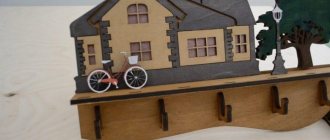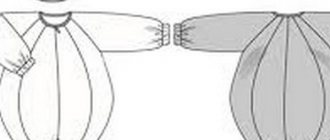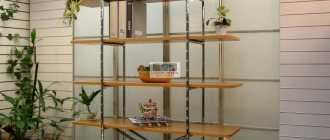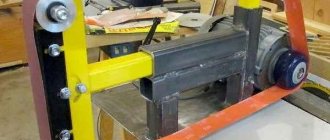- July 2, 2019
- Crafts
- Natalia Penchkovskaya
How to make a bench out of paper? If you need to create several shops for the layout of a city street or park, you can use the tips and samples given in our article. For work, we used only paper, corrugated cardboard, newspaper tubes or paper tubes. To attach the parts to each other, you need to prepare either thick PVA glue or a glue gun, depending on the selected material.
In the article we will look at several samples of interesting benches, how to make a simple bench out of paper using the origami technique. You will learn how to create an original craft from newspaper tubes and thick rolls from kitchen napkins. You can use larger paper tubes left over from packaging plastic wrap or linoleum to make a garden bench.
If you want to make lightweight, portable furniture for your garden, then corrugated cardboard packaging is perfect for this purpose. Let's start with a simple bench made of white or thick colored paper in A-4 format.
Requirements for creating a bench
In order to make a correct, strong, durable bench, it is necessary to take into account the following features of this work and follow certain principles:
- each bench should have comfort and convenience;
- its design should be so thoughtful and logical that it does not require unnecessary materials and tools for work;
- the size of the bench must fully satisfy those resting on it;
- to create a bench, you need to use materials available for work that can be easily found and brought;
- the selected material for a new bench must be of high quality, moisture resistant, and have high protection against temperature changes;
- Before making a bench, you should first familiarize yourself in detail with the information useful for this, and, if necessary, study the detailed drawings of the bench.
Necessary consumables and tools
To work with materials you will need tools: an angle grinder with discs, a screwdriver and screws, a drill, a level, iron angles, nails, screws and self-tapping screws. To process wood you will need sandpaper of varying hardness. In addition, you will need a tape measure, a compass, a simple pencil, and a ruler.
To work you will need a set of tools. For finishing you will need varnish, paint and a special product that protects against fungi and beetles. If necessary, galvanizing can be done to protect the metal from corrosion. For final finishing, special paints and varnishes will be required.
How to make a bench with your own hands from wood
The design of this bench is quite simple, so even an inexperienced craftsman, for whom this will be the first time, can make it. Below is a step-by-step description of how to make a wooden bench:
- First of all, you need to draw a diagram of the bench. This will help make the manufacturing process easier and faster, without unnecessary deviations and corrections;
- The side parts of the wooden bench are assembled. To do this, first drill the necessary holes in which all fasteners and additional elements will be connected;
- The sidewalls are secured with nuts and bolts. A sealed washer is placed under the nut, which should not be tightened too tightly right away. After all, during the work you will need to adjust its density;
- connecting the side parts of the future bench. They must be fixed and connected with large-diameter self-tapping screws. Also for this purpose, fasteners that have a turnkey head are used;
- fixing all details. To connect the sides and back of the bench, you should not attach the parts closely. There should be a hole of about 5 mm between them. Next, all elements are tightened and fastened;
- leveling the joints of self-tapping screws in wood using putty. At this stage, sandpaper is also used to clean out all the flaws and irregularities of the structure being created. Then this tree should be impregnated with an antiseptic and covered with paint;
After complete drying, the wooden bench is ready for use.
What to process?
In all the instructions listed above, among the last points, wood treatment was mentioned not only with decorative, but also with protective compounds. The fact is that wood is a material that does not tolerate contact with water and dampness, so without additional treatment it will certainly begin to deteriorate and rot. Benches made from natural components must be coated with suitable compounds, especially if these are street or country options.
Different mixtures are used to treat wooden benches. Let's get acquainted with the most current options.
- High-quality opaque paints of different colors and shades can completely hide the texture of natural wood. Different types of compounds can be used to treat garden furniture, but acrylic options are the most reliable and practical. Mixtures with a similar base form a more durable and long-lasting coating, which can have different colors. Solidification occurs in the form of a film.
- There is another popular composition - azure, which in many respects resembles a standard varnish, but in fact is not one. Unlike varnish, using the product in question does not leave a vapor-permeable film on the wood - the wood continues to “breathe” freely. Azure will enrich the natural material with rich, deep tones. In addition, this product easily penetrates into the wood structure, protecting it from fading under the sun, as well as from damage due to precipitation.
- Standard varnishes form a film coating on the surface of wooden structures and prevent dampness and moisture from penetrating underneath. The product can be either transparent or have a certain shade. For outdoor furniture, it is recommended to choose yacht varnishes, as they last much longer, protect more effectively and shine beautifully in the sun. Often colorless varnishes are applied in combination with various impregnations, for example, stain.
- The oldest solution is to treat wooden bases with oils. Such compositions can easily penetrate into the very depths of wood structures, giving them water-repellent properties, and at the same time an attractive shade.
How to make a bench with a back
To create a bench with a backrest with your own hands, the craftsman will need the following tools:
- mitral and circular saw;
- pencil;
- tape measure;
- drill with an optimal set of drills.
The following is a list of necessary materials for the future bench (all boards should be 2.5 m long):
- boards measuring 2x3 (7 pieces);
- 2x4 boards (1 piece);
- boards measuring 2x6 (1 piece);
- bars measuring 2x2 (2 pieces);
- glue for woodworking;
- sanding material;
- a set of screws of 5 cm and 8 cm.
To begin assembling a bench with a backrest, start from the back legs. But first you need to make sure that all the necessary boards are labeled and numbered. This will prevent confusion and corrections during assembly. Next, the front legs are added to the rear legs along with a seat, support for the armrests with lower stretchers. All fastening elements must be level and fix each other.
Before starting assembly, it is advisable to lay out all the boards in the desired order and shape to make sure that everything matches and fits. Only then are the fasteners connected to the structural elements.
One of the last stages of creating a bench with a back will be fixing the lower slats to the base of the frame. The seat and the backrest are attached to them from above. To hide the fastening materials (screws), they are drilled from the bottom and back of the planks.
Choosing a suitable tree in the garden
Choosing a suitable tree
When determining the location of a round bench, we do not recommend installing it around a young tree, as this may look a little ridiculous, especially since the tree grows quickly and over time the bench will crowd it out.
The thicker the tree, the nicer the round bench around it will look. It is also not advisable to stop at a fruit tree, since in summer or autumn you will have to clean the bench quite often from fallen fruits.
It’s so nice to lean against the bark of an old tree, enjoying the rustling of the leaves. Here you can sit alone, reading your favorite book, or spend unforgettable fun hours in the company of your best friends.
Practical tips for creating a garden bench
Making a garden bench with your own hands is also not difficult, because it has a fairly simple design. This bench is placed on four legs, which are all connected together. This ensures strength and secures the back well.
To create a classic garden bench, first of all, make a frame. To do this you need to prepare the following type of boards:
Note!
How to make a shoe rack with your own hands - simple and complex options. Step-by-step instructions with photos and descriptions
How to make a fence with your own hands: detailed instructions, diagrams, drawings. Description of the process from A to Z!
How to make a barbecue with your own hands from metal - the best manufacturing options with drawings and step-by-step instructions (100 photo ideas)
- 1.5 m boards (5 pieces);
- boards 0.36 m each (2 pieces);
- boards 0.52 m each (2 pieces). They are cut lengthwise into 4 bars, which are then used to fasten the seat and legs;
- boards 0.72 m each (2 pieces). In the future they will hold the back and legs together.
Having prepared the boards of the required size, they must be sanded and all defects and burrs on them must be eliminated.
Next comes the assembly of the frame itself. To begin, connect the legs together using self-tapping screws. Then a seat and back are attached to them. And so that the fasteners are not visible, they are placed on the reverse side. At the last stage of creating a garden bench, a lower bar is installed to secure the legs with the main structure.
When the entire bench is assembled, it is painted to protect it from temperature fluctuations and possible moisture. For painting, yacht varnish or special impregnation is recommended. But it is worth remembering that after using the varnish, such a bench will always be cold.
Features of lumber
You can make a bench around a tree with your own hands from different lumber:
- timber;
- boards;
- plywood.
Each of the above materials has its own technical characteristics, advantages and disadvantages. They are distinguished by their naturalness and environmental friendliness, beautiful texture, and affordable price. These lumbers are easy to work with as they can be sawed and cut with both hand and power tools.
Important: when treating lumber with antiseptics or impregnations, special attention is paid to cross sections, since they absorb moisture the most.
Assembling a garden bench from a pipe
A garden bench made of a profile pipe is considered more difficult to manufacture than, for example, a bench made of wood. But thanks to its practicality and durability, it still remains popular and one of the favorites among consumers.
To assemble it you will need:
Note!
DIY country washbasin - review of simple and complex designs (97 photos of the best ideas)
- How to make a garden (construction) wheelbarrow with your own hands: detailed instructions with description + 85 photos of fresh ideas
- How to make a hot smoked smokehouse with your own hands: drawings, dimensions, choice of material, photos of finished options
- rectangular pipe measuring 2.5x5.5 cm and 5 m long;
- soft metal sheet measuring 2.5x20.0 cm;
- soft metal sheet measuring 10x30 cm;
- flat head screws (26 pieces);
- screws 3 cm (4 pieces).
All elements are connected using a welding machine. If it is not there, then parts for the bench will have to be ordered from special workshops.
In addition to the metal frame, this bench also uses wooden slats. You can paint it either with paint or varnish. This will give the bench a more aesthetic and attractive appearance.
Practical recommendations
- If you deviate a little from the size of the bars and support boards, there is nothing wrong with that, the design of the bench will just change a little, and it will still look impressive in the photo. However, the outer frame should still be in the shape of a square. The dimensions of the short sides are decisive, and to the long sides it is worth adding the thickness of the timber, multiplied by 2.
- Water can penetrate the wood through the lower parts of the legs, so it is recommended to treat them with glaze or special oil. A wax-like composition gives a good effect; in the photo, a bench soaked in this product will look great.
- If you are going to make a backrest, you should provide 4 components, 4 backrests and loose seats in advance. As a result, when assembled, you will get an octagon.
- The load capacity of the finished product is sufficient. If you think that the load will be large, install additional supports in the inner square. But if the soil is uneven, installation may cause problems.
- If the elements of the bench have been processed under pressure, the product will be resistant to sunlight and adverse weather conditions. In this case, the wood should not be painted; the sections are not subject to additional processing.
- It is recommended to tilt the backrests slightly back. The design of the legs with two points of support on the seat allows you to give the bench stability.
- It is important to determine in advance where the bench will be placed. Before installation, markings are made on the ground in the form of a regular 6-pointed star or octagon. Drawing a star is very simple - place 2 equilateral triangles on top of each other.
Step-by-step instruction
Making drawings
The bench is usually made of 6 parts of equal size; in the photo it looks very original. You must first determine the diameter of the tree trunk. If it is young, you need to add 30 centimeters, if it is an adult - 15. To determine the length of the short part of an individual element, divide the amount by 4. Mark the length on the measuring rod and saw off the edges at an angle of 30 degrees.
Product size
To make a bench, make a starting board template based on the identified dimensions with corners cut at 30 degrees. Next, you should lay 3 boards parallel to the board and separate them with centimeter spacers. The slats are applied to the wooden elements (taking into account the angle of 30 degrees of the initial board). Make a mark.
Sawing boards
The cut should be made like this. Set the saw at 30 degrees. Cut the 3 boards marked earlier to length with opposite corners at both ends.
Assembly
Now you need to assemble a hexagon with your own hands. This is done on a flat surface, do not forget to add centimeter spacers. You should start from the inside of the seat. It is important to check whether the angles are appropriate.
Legs
Making the legs is quite simple. They include an inner and outer leg located between 2 supports. It will take 12 elements to assemble 6 frames. Make 12 supports. The end of each of them should be sawed off at an angle of 30 degrees.
Bolt holes
Although they are not visible in the photo, the recesses for the bolts should be prepared in advance. Take a drill and make holes, the distance from the front edge of the outer support should be 5 centimeters. At the indicated location, make a mark on the vertical flat side. Repeat the procedure on the other side of the support.
Securing the legs
Fasten the supports and legs with your hands. Place the bolts into the holes. Use an adjustable wrench to tighten the bolts with the nut and washer.
Section assembly
Place your feet vertically on a flat surface with your hands. Secure using clamps. At the top of the leg of the assembly, install spacers between the boards. The edge of the board should be halfway up the leg of the assembly. The boards are fixed to the feet with self-tapping screws . Secure the legs into 4 sections. As a result, there should be 2 groups, each with 2 sections. Install the last section. Place 2 groups on opposite sides of the trunk. Secure them with the remaining 2 sections.
End of work
Level the product. To do this, use a spatula to dig the legs into the ground. If necessary, cut out and install the backrests, that’s all, before you is an almost finished bench that will look good in a photo in a family album. All that remains is to make the apron.
To do this, measure the distance between the long support points in the sections. Make 6 beams at an angle of 30 degrees. Secure the block using a clamp. Next, you need to drill holes and install them on the outer leg. All sections should be processed similarly. The final stage is grinding the roughness. The end result will be a very comfortable bench.
We also recommend that you read a previously published article on our website, in which we talked about how to make wooden furniture for a summer house.
Preparatory work
Dimensions
In order for the bench to stand level, it is necessary to level the area around the tree. Remove excess soil and add a little where necessary. Be careful not to damage the tree's roots. For the same reason, it is not recommended to concrete the legs of a future bench by digging holes in the ground. If possible and desired, the area where the bench will be located can be sprinkled with fine crushed stone or gravel.
So let's get to the fun part. This article provides several options for a ring bench. But first, let's look at how to make the easiest bench to make around a tree - a quadrangular one.
Photo
The photographs provide several original ideas for making a bench around a tree:
Sectional bench
Forged bench
On the embankment
On the street
In landscape design
Yard bench
Outdoor table for a summer residence drawings
To make a table for the yard with your own hands, you need to acquire an exact drawing of it, which indicates not only the dimensions of the product, but also the materials for its manufacture. You can make such a drawing yourself by drawing it by hand or choose the most suitable option on the Internet.
Attention: having a well-drawn drawing of the future piece of furniture will prevent errors in the process of manufacturing its parts and their assembly.
The following parameters must be indicated on the diagram of future furniture:
- height;
- depth;
- width;
- length.
Attention: when choosing the size of country furniture, you should take into account not only standards, but also personal wishes and the size of your garden plot.
If the dimensions of the yard allow it, then the ideal option would be to build a bench with a table with your own hands. It will fit harmoniously on the veranda, terrace, gazebo or simply in the middle of the garden. This design has many advantages:
- spaciousness;
- aesthetics;
- functionality;
- practicality;
- ease of use;
- good stability.











